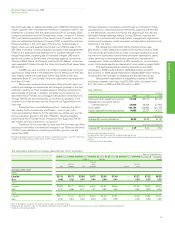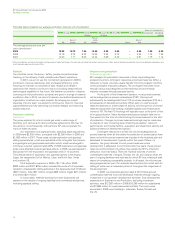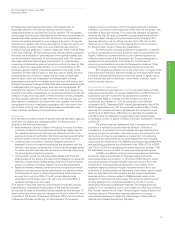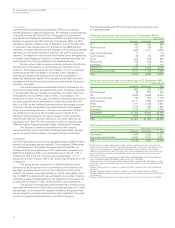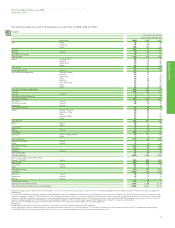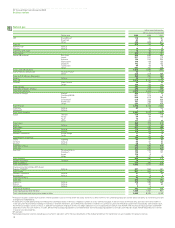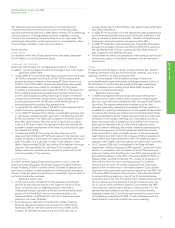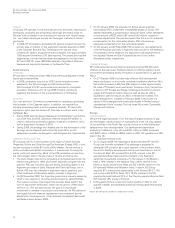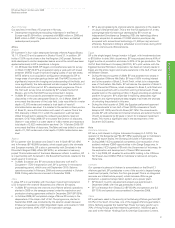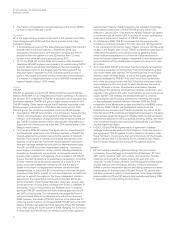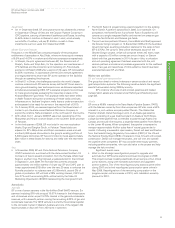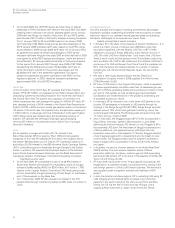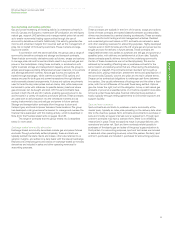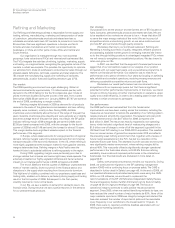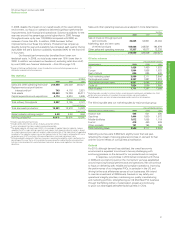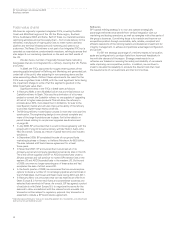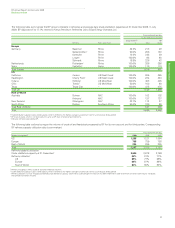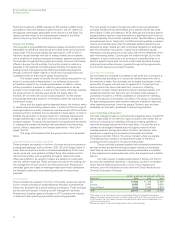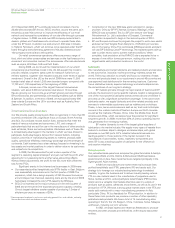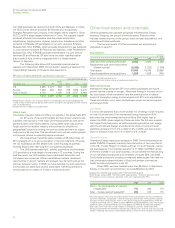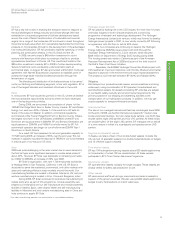BP 2009 Annual Report Download - page 35
Download and view the complete annual report
Please find page 35 of the 2009 BP annual report below. You can navigate through the pages in the report by either clicking on the pages listed below, or by using the keyword search tool below to find specific information within the annual report.
33
BP Annual Report and Accounts 2009
Business review
Business review
Business review
Kazakhstan
• On 11 December 2009, BP announced that it has divested its interest
in Kazakhstan’s Tengiz oil field and the Caspian Pipeline Consortium
(CPC) pipeline, carrying oil between Kazakhstan and Russia, by selling
its 46% stake in LukArco to Russia’s Lukoil. Lukoil, which already
owns 54% of LukArco, will pay $1.6 billion in cash in three
instalments over two years from December 2009.
Middle East and Pakistan
Production in the Middle East consists principally of the production
entitlement of associates in Abu Dhabi, where we have equity interests
of 9.5% and 14.67% in onshore and offshore concessions respectively.
• In Sharjah, the joint agreement between BP, the Government of
Sharjah, Itochu and Tokyo Beki, for the operation and maintenance of
LPG facilities and the production and marketing of LPG products,
expired on 22 March 2009 after a period of 25 years. BP relinquished
its 25% ownership, in accordance with the joint venture agreement,
and negotiated terms that retain BP as the operator of the facilities
through an operating fee structure.
• In Block 61 in Oman, the challenges posed by the world’s largest
onshore wide-azimuth 3D seismic survey led the BP Oman team to
use a ground-breaking new technique known as distance separated
simultaneous sweeping (DS3). BP’s appraisal programme continues
to make good progress evaluating the resources in place in the
Khazzan/Makarem gas fields. Five appraisal wells have been drilled
in 2009. Fracture stimulation and testing of these wells continues.
Infrastructure to facilitate long-term wells tests is under construction
and expected to be ready for service in the second half of 2010.
• On 3 January 2010, we received approval from the Government of
Jordan to join the state-owned National Petroleum Company to
exploit the onshore Risha concession in the north-east of the country.
• With effect from 1 January 2009 BP assumed operatorship of the
Mirpurkhas and Khipro onshore blocks in the southern Sindh province
of Pakistan.
• In the third quarter of 2009, BP won bids for two new exploration
blocks, Digri and Sanghar South, in Pakistan. These blocks are
adjacent to BP’s Mirpurkhas and Khipro concession areas and add
another 5,000 square kilometres to the group’s existing portfolio of
5,300 square kilometres. BP has committed to invest approximately
$30 million in these blocks for seismic and wells over the next three
years.
Iraq
• In November 2009, BP and China National Petroleum Company
(CNPC) entered into a contract with the state-owned Southern Oil
Company of Iraq to expand production from the Rumaila oilfield near
Basra in southern Iraq. This followed a successful bid for the contract
in Baghdad in June 2009. The Rumaila field currently produces
approximately one million barrels of oil per day. BP and CNPC plan to
invest approximately $15 billion over the next 20 years to enhance the
Rumaila production to a plateau rate of 2.85mmb/d, around 3% of
global oil production. BP will hold a 38% working interest, CNPC will
hold 37% and the remaining 25% will be held by the State Oil
Marketing Organisation (SOMO) representing the Iraqi government.
Australasia
Australia
BP is one of seven partners in the North West Shelf (NWS) venture. Six
partners (including BP) hold an equal 16.67% interest in the infrastructure
and oil reserves and an equal 15.78% interest in the gas and condensate
reserves, with a seventh partner owning the remaining 5.32% of gas and
condensate reserves. The NWS venture is currently the principal supplier
to the domestic market in Western Australia and one of the largest LNG
export projects in Asia with five LNG trains in operation.
• The North Rankin 2 project linking a second platform to the existing
North Rankin A platform sanctioned in 2008, is on schedule. On
completion, the North Rankin A and North Rankin B platforms will
operate as a single integrated facility and recover low pressure gas
from the North Rankin and Perseus gas fields.
• The joint venture partners (Chevron, ExxonMobil and Shell) approved
the Greater Gorgon project on 14 September 2009 with the Australian
Government also awarding production licences for the Jansz-Io field
(BP 5.375%). The Jansz-Io field will be developed as part of the
Greater Gorgon project, which will comprise three LNG trains, each
with a capacity of 5 million tonnes per annum (mtpa), on Barrow
Island with first gas expected in 2014. As part of this, a unitization
and unit operating agreement has been executed with the joint
venture partners and sales and purchase agreements for the wellhead
sale of raw gas and repurchase of LNG ex-Barrow Island have been
executed between BP and Shell.
Midstream activities
Oil and natural gas transportation
The group has direct or indirect interests in certain crude oil and natural
gas transportation systems. The following narrative details the significant
events that occurred during 2009 by country.
BP’s onshore US crude oil and product pipelines and related
transportation assets are included under Refining and Marketing (see
page 36).
Alaska
BP owns a 46.9% interest in the Trans-Alaska Pipeline System (TAPS),
with the balance owned by four other companies. BP also owns a 50%
interest in a joint venture company called ‘Denali – The Alaska Gas
Pipeline’ (Denali). Denali has begun work on an Alaska gas pipeline
project, consisting of a gas treatment plant on Alaska’s North Slope,
a large diameter pipeline that is intended to pass through Alaska into
Canada, and should it be required, a large-diameter pipeline from Alberta
to the Lower 48 states. When completed, the pipeline is expected to
transport approximately 4 billion cubic feet of natural gas per day to
market. Following a successful open season, Denali will seek certification
from the Federal Energy Regulatory Commission (FERC) of the US and
the National Energy Board (NEB) of Canada to move forward with project
construction. Denali will manage the project, and will own and operate
the pipeline when completed. BP may consider other equity partners,
including pipeline companies, who can add value to the project and help
manage the risks involved.
Significant events were:
• Work on the strategic reconfiguration project to upgrade and
automate four TAPS pump stations continued to progress in 2009.
This project involves installing electrically driven pumps at four critical
pump stations, along with increased automation and upgraded
control systems. Two of the reconfigured pump stations came online
during 2007 and a third reconfigured pump station came online in
May 2009. Reconfiguration of the remaining pump station in the
programme plan will commence in 2010, with installation currently
planned for 2012.


